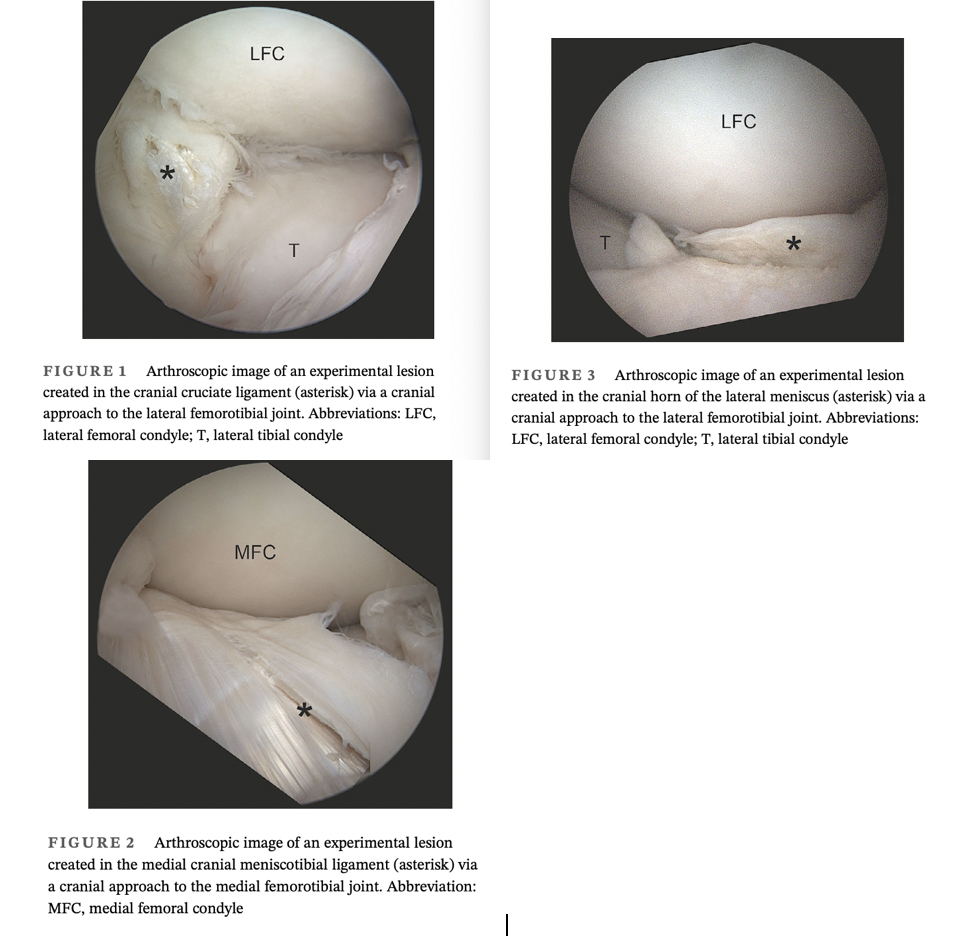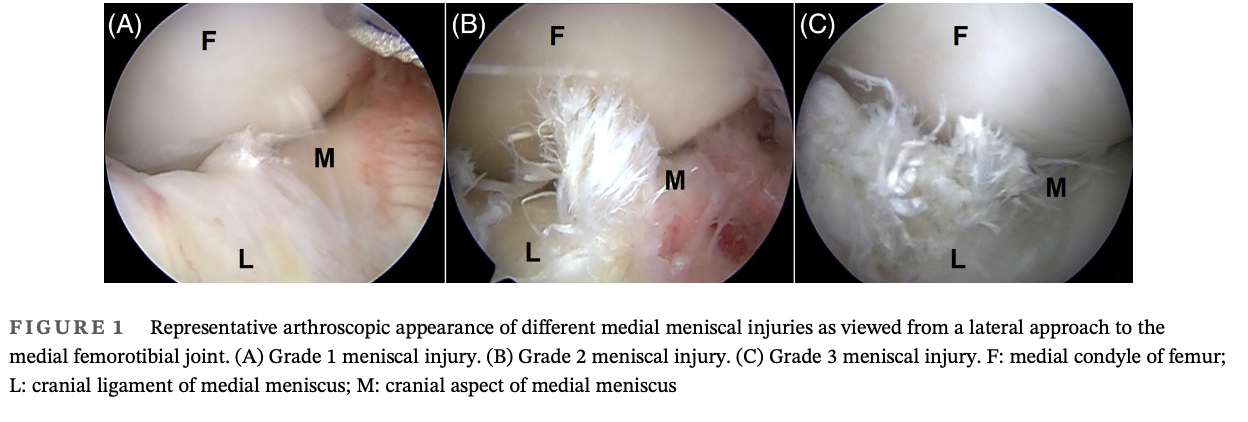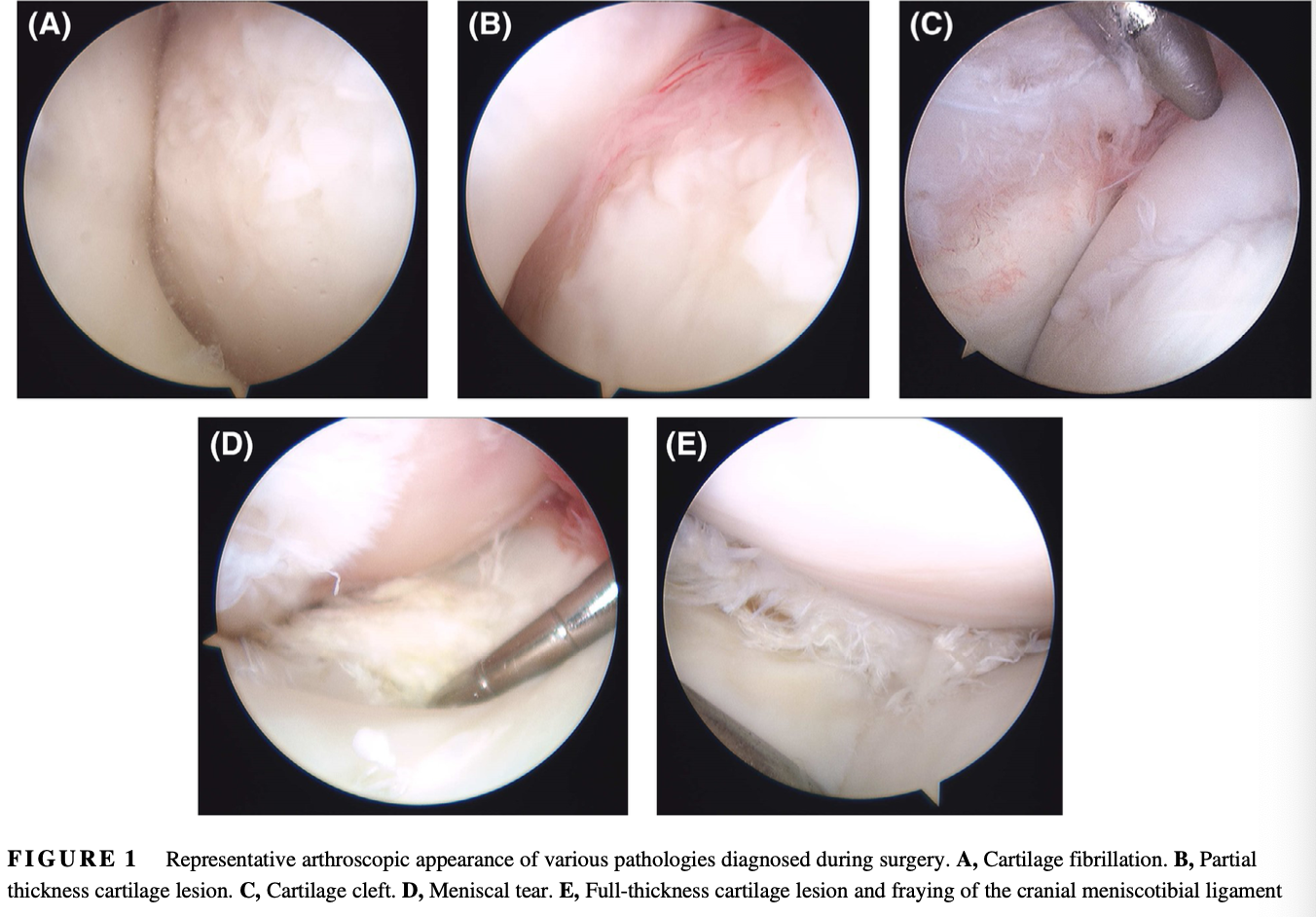Ch 101 Papers
1/6
There's no tags or description
Looks like no tags are added yet.
Name | Mastery | Learn | Test | Matching | Spaced |
|---|
No study sessions yet.
7 Terms
ABmann et al, 2022
MRI vs CT Arthrography for Soft Tissue Stifle Lesions
Objective: To determine the diagnostic performance of computed tomographic arthrography (CTA) and 3 Tesla magnetic resonance imaging (MRI) for detecting artificial meniscal, meniscotibial ligament (MTL) lesions and cruciate ligament (CL) lesions in horses
Results:
Sensitivity and specificity of MRI (41% and 86% respectively) and CTA (32% and 90% respectively) did not differ
The sensitivity (MRI: 24-50%; CTA 19-40%) and specificity (MRI: 75-92%;CTA 75-100%) of imaging modalities did not differ when detecting lesions of the menisci, MTLs, and CLs
The highest sensitivities were achieved when MTLs were avaluated with MRI (50%) and CLs with both modalities (40%)
CTA sensitivity was best for cruciate ligament lesions and least sensitive when diagnosing meniscal lesions
Conclusions: The diagnostic performance of CTA was comparable with that of MRI, with a low to moderate sensitivity and high specificity. Computed tomographic arthrography should be considered as an adjunct to diagnose CL injuries

Davis and Garcia-Lopez, 2022
Arthroscopic Findings and Outcomes in Sport Horses with Meniscal Injuries
Objective: To report the findings and long-term outcome of 76 sport horses with meniscal injury
Results:
The medial meniscus was involved in 82.8% of cases with grade 1 injuries diagnosed in 76.3% of menisci
Overall, 85.5% of horses returned to athletic performance with 40% returning to their previous level
The grade of meniscal injury was associated with long-term outcome
Horses with grade 1 meniscal injuries had a better long term outcome than horses with grade 3 meniscal injuries
There were no difference in long-term outcome between horses with grade 1 and grade 2 injuries or between horses with grade 2 and grade 3 injuries
The presence of preoperative radiographic abnormalities or additional joint pathology was not associated with long-term outcomes
59 stifles were treated with an orthobiologic: autologous conditioned serum, platelet-rich plasma, or marrow-derived mesenchymal stem cells
There was no association between the use of any orthobiolgoic and long-term outcome
The presence of articular cartilage fissure in the femoral condyle was associated with a negative long term outcome
Conclusion: This is the first report on long-term outcome of sport horses with meniscal injuries following arthroscopic surgery. Overall, the longer-term prongosis was fair with 40% of horses returning to their previous level of use. Severity of the meniscal injury was a prognostic indicator for return to work. The presence of radiographic abnormalities or additional joint pathology or the use of orthobiologisc was not associated with long-term outcome

Frazer, Santschi, and Fischer 2019
Bone Stresses and Peak Contact Pressures in Medial Femoral Condyles
Objective: To predict bone and medial meniscal stresses and contact pressures in an equine stifle with a medial femoral condyle (MFT) intact or with a 2 cm³ subchondral bone void, under varying degrees of internal femoral rotation (IFR)
Results:
The main stresses found in the intact MFC were in compression, with very small areas of shear and tension
Adding a 2cm³ MFC void increased peak compression stress by 25%, shear by 50%, and tension by 200%
An MFC void also increased tension and shear placed on the medial meniscus by 30%
Under load, IFR of 2.5* and 5* increased MFC peak stresses 8-21%
Conclusion: A 2 cm³ MFC void in an equine stifle finite element model (FEM) increased stress in bone and meniscus. Internal femoral rotation slightly increased predicted bone stress. Increases in bone and meniscal stressed predicted in an MFC with a void provide evidence to inderstand the persistence of voids and mechanism of damage to the medial meniscus
Frazer, Santschi, and Fischer, 2019
Stimulation of subchondral bone cyst healing by placement of a transcondylar screw
Objective: To predict the bone formation stimulus of a transcondylar screw across an equine subchondral bone cyst (SBC) in an equine medial femoral condyle (MFC)
Results:
At 750 cycles and 900 N load, <3% of the total bone surface area (BFA) exceeded the threshold for bone formation (BFT)
Increases in BFA > BFT occurred proportionally with load, screw compression, and daily cycles (steps)
Compressive stress was oriented vertically on the SBC surface without a screw but aligned with the long axis of well-placed lag screws
Screw placement through the void also increased the number and magnitude of compressive vectors
Conclusion: This model predicted that a transcondylar lag screw across an MFC SBC increased surface BFA stimulation and reoriented the compression vector. Increasing screw compression, load, and steps per day increased the bone formation stimulus.
Klein et al, 2022
Comparison of 3 Treatments for Medial Femoral Condyle Cysts in Thoroughbred Racehorses
Objectives: To compare 3 different methods for treatment of medial femoral condyle (MFC) subchondral cystic lesions in Thoroughbred horses <24 months old based on criterion of ability to race post-treatment
Results:
73% raced post-treatment
72% treated by arthroscopic debridement
84% treated with intralesional MSCs
68% treated with intralesional corticosteroids
There was no difference between groups in the ability to start a race
Sex, limb affected, and lesion size also had no effect on the ability to start a race
There was a trend for increasing lesion size reducing the probability of racing
For each mm increase in joint defect size, the likelihood of racing decreases by 10%
Conclusion: 73% of the horses raced but there was no difference in the ability of unraced Thoroughbreds to race after treatment of MFC subchondral cystic lesions with arthroscopic debridement, intralesional mesenchymal stem cells, or intralesional corticosteroids. The three reported treatments may be considered for treatment of MFC subchondral cystic lesions with a good prognosis for racing post-treatment. Owners should be advised that increasing lesion size decreases the probability of racing
McCoy et al, 2019
Outcome After Stifle Arthroscopy in Western Performance Horses
Objective: To report the outcome of horses engaged in Western performance disciplines after stifle arthroscopy and identify prognostic factors for return to performance
Results:
Most common disciplines represented were cutting (n+38), Western pleasure (n=13), and reining (n=13)
Approximately 40% of horses returned to intended use after surgery
Increased age, higher degree of lameness, longer duration of lameness, and the presence of partial-thickness cartilage lesions decreased the odds of returning to athletic performance
Postoperative therapies (intra-articular: stem cells, corticosteroids, IRAP, HA/polysulfated glycosaminoglycans; systemic: NSAIDs, HA/polysulfated glycosaminoglycans, oral joint supplements) did not affect the odds of returning to intended use
Conclusion: Less than half of the Western performance horses that underwent stifle arthroscopy returned to intended use. Older age, longer duration of lameness, and presence of partial-thickness cartilage lesions affected the odds of a horse returning to intended use. Postoperative therapies did not affect the outcome in this population. The prognosis of Western performance horses undergoing stifle arthroscopy is as guarded as that previously reported in horses of other disciplines

Moreno et al, 2022
Failure of a Medial Femoral Condylar Screw and Lag vs Neutral Placement
Objective: To determine the failure method of simulated equine medial femoral condyle (MFC) subchondral bone defects under compression and the influence of screw placement on failure resistance
Results:
Specimens failed by cracking at the superior aspect of the void or the screw exit hole
After monotonic loading, cracks were observed 6/6 composite disks (CD) with a void, 6/6 CD with a void/lag screw, and 5/6 CD with a void/neutral screw
After cyclical testing, crackers were noted only on the superior aspect of 6/6 CD with a void and 3/6 CD with a void/lag screw
Displacement at peak load was 0.06 mm (intact), 0.32 mm (void), 0.24 mm (void/lag screw), and 0.11 mm (void/neutral screw)
Conclusion: Model MFC voids failed by superior cracking that was resisted by lag and neutral screw placement. Neutral screws may be an acceptable treatment for subchondral lucencies in the MFC